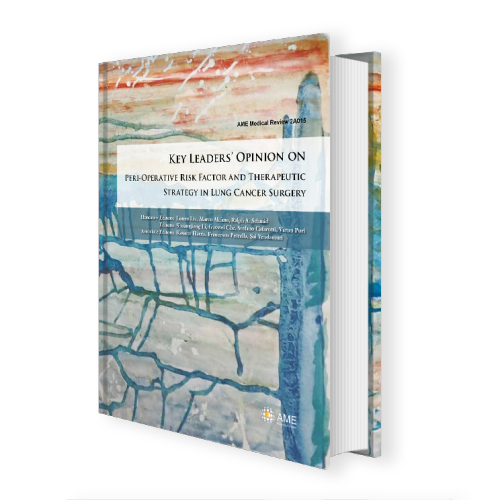
| Editors: | Shuangjiang Li, Guowei Che, Stefano Cafarotti, Varun Puri |
The Key Leaders’ Opinion on Peri-Operative Risk Factor and Therapeutic Strategy in lung cancer surgery, is a collection of over 80 insightful commentary papers recently published by the experts with rich experiences in this research field working in renowned institutions around the world, which provides an exhaustive review of current hot issues worthy debating on the putative prognostic risk factors and the relevant treatment options.
In its first section, Prognostic and Risk Factors, the authors summarize a variety of perioperative parameters recently reported to affect short-term complications and long-term survival from five major aspects, including body composition analysis, host immune-nutritional status, baseline function and performance, intraoperative morbidity and pathological variables majoring in tumor spread through air spaces.
In its second section, Peri-Operative Care and Therapeutic Strategy, the authors contribute to optimize the preventive and therapeutic strategies based on their personal expertise in perioperative care from six major aspects, including elderly health care, enhanced recovery after surgery, fissureless technique, comparison between surgery and stereotactic body radiation therapy, intraoperative therapy and postoperative management.
In this way, the readers will have a comprehensive scenario of the current situation and consideration of the prognostic risk factors and the relevant therapeutic strategies in lung cancer surgery. This book may give great help to thoracic surgeons with their multidisciplinary teams to draw up more accurate and personalized treatment schemes based on the reported risk factors for the patients who are identified at a high probability of unfavorable outcomes.
HONORARY EDITORS
| Lunxu Liu | Department of Thoracic Surgery, West China Hospital, Sichuan University, Chengdu, China |
| Marco Alifano | Department of Thoracic Surgery, Cochin Hospital, University of Paris, Paris, France |
| Ralph A. Schmid | Division of General Thoracic Surgery, Inselspital, Bern University Hospital, Bern, Switzerland |
EDITORS
| Shuangjiang Li | Department of Thoracic Surgery, West China Hospital, Sichuan University, Chengdu, China; Division of General Thoracic Surgery, Inselspital, Bern University Hospital, University of Bern, Bern, Switzerland |
| Guowei Che | Department of Thoracic Surgery, West China Hospital, Sichuan University, Chengdu, China |
| Stefano Cafarotti | Department of Thoracic Surgery, San Giovanni Hospital, Bellinzona, Switzerland |
| Varun Puri | Division of Cardiothoracic Surgery, Washington University School of Medicine, St. Louis, MO, USA |
ASSOCIATE EDITORS
| Kassem Harris | Department of Medicine, Division of Pulmonary Critical Care, Interventional Pulmonology Section, Westchester Medical Center, New York Medical College, Valhalla, NY, USA |
| Francesco Petrella | Department of Thoracic Surgery, IRCCS European Institute of Oncology, Milan, Italy; Department of Oncology and Hemato-oncology, University of Milan, Milan, Italy |
| Sai Yendamuri | Department of Thoracic Surgery, Roswell Park Comprehensive Cancer Center, Buffalo, NY, USA |









